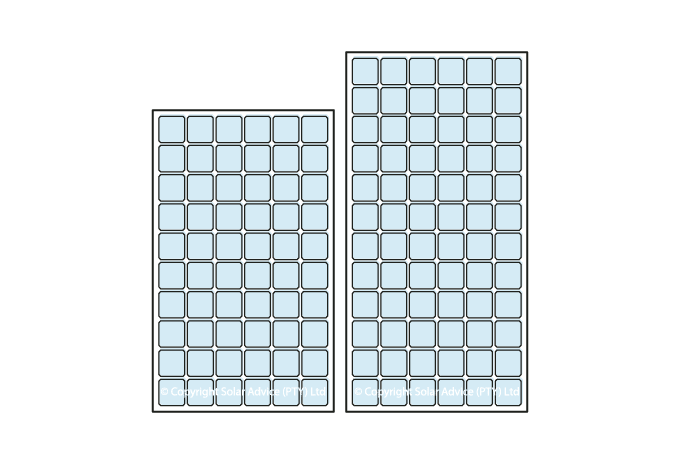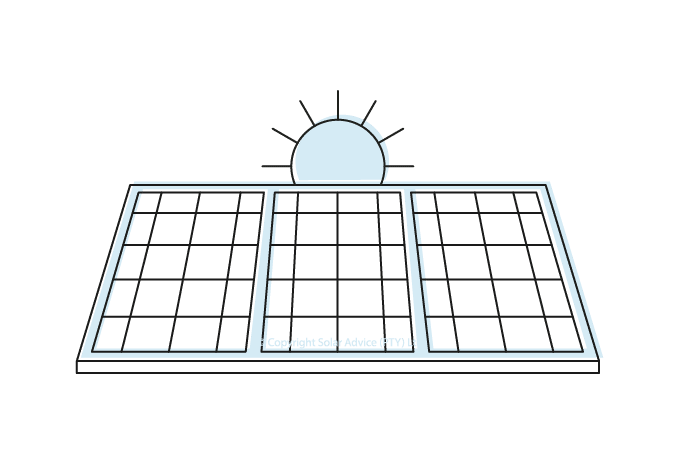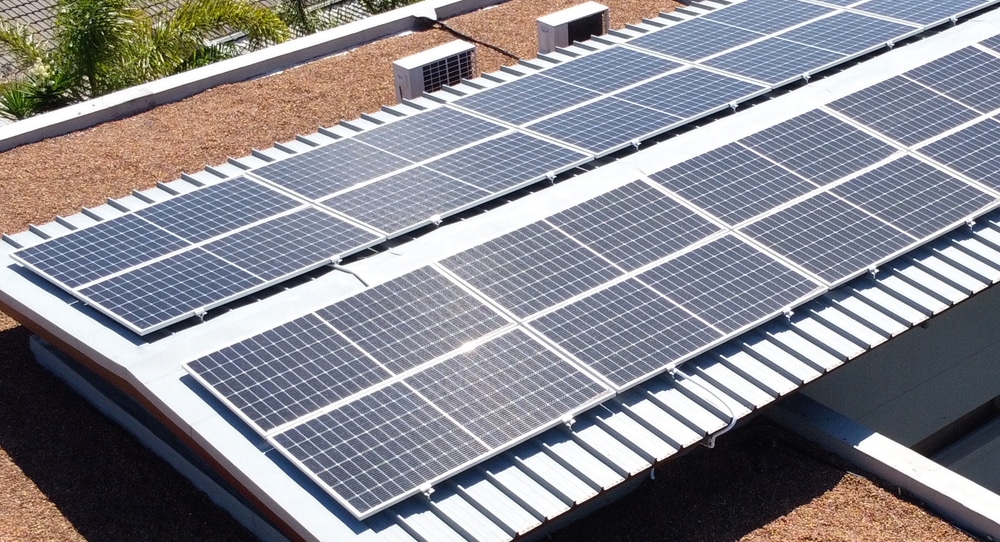South Africa has perfect weather conditions for a Solar Array, so it makes sense that we explore Solar solutions as an alternative to nuclear power.
Sizing a solar panel array is an essential part of creating a solar power kit.
You now know what inverter you want. But, how do we go about sizing solar panels?
Well, it’s quite simple.
Keep reading on to learn everything you need to know about solar panel sizing.
Topics we will be covering:
- Fundamentals
- How to Size an Array
- Case Study 1 – Low Voltage Inverter
- Case Study 2 – High Voltage Inverter
- Case Study 3 – Hybrid Inverter
- Conclusion
Chapter 1
Solar Panel Array: Fundamentals
Let’s start from the top
But, before we delve into the technical details of sizing your array, let’s go through some fundamentals first.
If you are electrically challenged (like I was), this might be beneficial before we get started.
This section is for complete beginners.

MPPT

An MPPT (Maximum Power Point Tracking) tracks the voltage coming from the PV array and maximises the energy produced by the array.
PV Array

Photovoltaic Array refers to your solar panel setup.
PV String

A group of solar panels whose combined voltage does not exceed the maximum MPPT range.
Watts

Wattage is a measurement of electricity.
Volts

Voltage is the rate at which electricity travels.
Parallel

This way of connecting solar panels increases the amps.
Series

This way of connecting solar panels increases the voltage.

Want to Learn More About Solar Inverters?
Our inverter Guide will tell you everything you need to know about Solar inverters.
Click HereChapter 2
How to Size a Solar Panel Array
Let’s take a closer look
Let’s take a closer look at sizing up an array according to your inverters solar charger data.
Firstly, find the inverter and the panel datasheet.
Secondly, look for the Max PV Input and the Max MPPT Range value on the inverter datasheet.
Thirdly, look for the Max Power and the Open-circuit Voltage. (VOC) on the panel datasheet.
Finally, follow the instructions below:

In this instance, we’ll use 4500w.
Second, we’ll look at the power rating of the panel; in this example, we are using 400W panels.
Third, we divide the maximum PV array input by the panels power rating:
4500W
400W
11.25
We will round it down to 10 panels.
Lastly, we need to figure out how many panels you’ll need in a string.
You do this by checking what the maximum MPPT range is. Then take that number and divide it by the maximum power voltage. This will give you the number of panels per string:
115V
49V
2.35
Again, we’ll need to round this number down to 2 panels per string.

Want to Learn More About Solar Panels?
Our Solar Panel Guide will tell you everything you need to know about Solar Panels.
Click HereChapter 3
Solar Panel Array: Case Study 1
5kW Low-Voltage Inverter with 400W Panels
He will need to find out how many panels his inverter can handle and how many strings he will need to have to max out his array.


Firstly, he is going to find the key values on both his inverter and panels’ datasheets.
Then he is going to use a simple equation to determine the number of panels he can use with his inverter:
4500W
400W
11.25
If the number you get is an odd number, it will need to be rounded down to the nearest even number.
In this case, the maximum number of panels Jim would need is 10.
Now Jim will need to know how many panels he can have in each string.
He uses another basic equation to work this out too:
115V
49V
2.04
Again, we are going to round this number down to 2. This means you can have two panels per string.
Jim has decided to go with the maximum amount of panels. So this means he is going to have five strings of 2 panels.
He will need to make sure to purchase a combiner box so that he can connect all of the strings to his single MPPT inverter.
See Array Comparison Below
With A Combiner Box

Without A Combiner Box

The Bottom Line
5
2
4kW
18kW
6.57MW
*Power production are averages that are based on a 5.5 hour production time per day. Installation, weather, shading, and soiling all affect these figures.
Chapter 4
Solar Panel Array: Case Study 2
5kW High-Voltage Inverter with 400W Panels
Now all he needs to do is work out the details of his array. George is not sure what size panel he should buy, so below, we have two different examples with the same inverter but different panels.


Scenario 1
Again, we are going to work out how many panels he needs:
5500W
400W
13.75
To work out the number of strings. This time, we will be able to fit more panels in a string, thanks to the higher voltage range of the inverter. That gives us a rounded down maximum total of 12 panels.
430V
49V
8.77
Rounded down: 8 panels.
However, because your Maximum PV array is 5500W, you will only be able to have six panels per string.
See Diagram Below

The Bottom Line
2
6
4.8kW
26.4kW
9.6MW
*Power production are averages that are based on a 5.5 hour production time per day. Installation, weather, shading and soiling all affect these figures.
Scenario 2

The same exercise can be done using a smaller panel, like a 330W, and this is what your calculations would look like:
5500W
330W
16.66
Now let’s work out the strings: Round it down: 16 Panels.
430V
49V
8.77
Round it down: 8 panels per string.
See Diagram Below

The Bottom Line
2
8
5.3kW
29kW
10.5MW
*Power production are averages that are based on a 5.5 hour production time per day. Installation, weather, shading and soiling all affect these figures.
Chapter 5
Solar Panel Array: Case Study 3
8kW Hybrid Inverter with 400W Panels
The equation to work out his PV array will be the same as the first two case studies. However, Juan has bought a hybrid which has 2 MPPT’s, instead of the usual 1 MPPT.


Not only will Juan be able to have up to 4 strings of panels without having to use a combiner box, but he will have a far more efficient array.
Here’s why:
If one of the arrays is unable to function correctly due to shading or soiling, Juan has another array that can still work at full capacity. This will ensure that Juan’s system is still generating solar power.
Let’s work out Juan’s array size.
Firstly, he is going to find the key values on both his inverter and panels’ datasheets.
Then he is going do the maths to determine the number of panels he can use with his inverter:
10400W
400W
26
We don’t need to round it down this time so Juan can have a maximum of 26 panels in total.
Then we need to divide that by 2 (MPPT), and we have 13 panels per MPPT.
We will need to work out how many strings Juan can have on each MPPT so we do the sum:
425V
49V
8.67
Juan can have a maximum of 8 panels per string.
However, because Jaun can only have a maximum of 26 x 400W panels, he won’t be able to put 8 panels on 4 strings as this will exceed the Max PV Input.
Remember that each string needs to have the same number of panels per MPPT. So, while we cannot divide 13 equally, we can put 14 panels on one MPPT, and we can put 12 on the other.
See Diagram Below

The Bottom Line
2
7
2
6
10.4kW
57.2kW
20.8MW
Chapter 6
Solar Panel Array: Conclusion
Got a question?
Remember to take both the Maximum PV Array Input and the MPPT Voltage Range into consideration when you are sizing up your array.
If you have any questions, please Contact Us.

